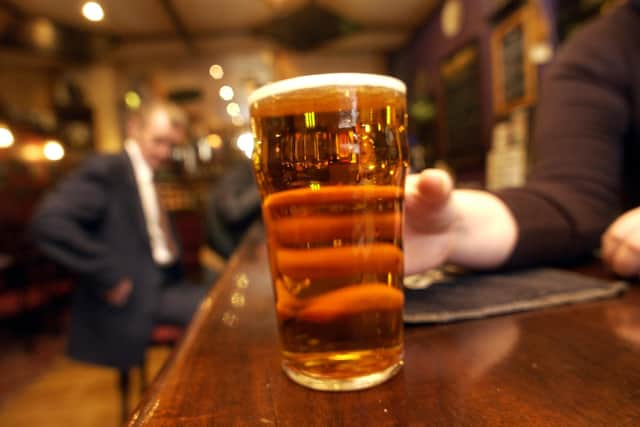Alcohol advertising ban Scotland: Will it tackle the nation's problem relationship with drink, as punters say 'I don't drink because of adverts'
It is a crisp weekday midafternoon, and the 56-year-old is several pints to the wind. “Day off the day,” he smirks. Ally, by his own admission, enjoys a good bevvy, but insists it does not define his life. “I’ll be up at six in the morning right as rain,” he says. “Out with the dog, then work. No problem.”
I have come to this nook in Glasgow’s east end to gauge opinion about the Scottish Government’s proposed ban on alcohol advertising. Will it help tackle the nation’s problem relationship with the drink? Ally becomes animated, pointing his fag as he answers. “The problem isn’t the drink,” he tells me. “The problem’s poverty. That’s what needs solved. Look around you, it’s obvious, isn’t it?”
Advertisement
Hide AdAdvertisement
Hide AdIt is a fair point. Ally’s boozer is situated in Carntyne, an area of the city that occupies an ignominiously high position in the Scottish Index of Multiple Deprivation. Once a village with a thriving coal industry, it is now home to a sprawling housing estate and myriad challenges. The average life expectancy for a man born here is just 69. Almost a third of the population have a disability and the number of children living in poverty is a third higher than even the Glasgow average.
So what needs to change? Ally’s pal, George, a stout, ruddy faced wee man with a Lynyrd Skynyrd T-shirt, begins to answer before I finish the question. “Investment, social housing, good jobs,” he barks. “It’s no’ rocket science. Do you think taking down a Tennent's billboard is going to make a difference or improve the lives of folk here?” There is no anger in his voice. Despair, perhaps, but no anger.
Ally nods along. “He’s spot on,” he cuts in. “I don’t drink because an advert tells me to drink. I do it because there’s f*** all else to do about there. If an advertising ban helps some people, magic. I understand there are people who can’t help themselves. But it’s not going to change anything for me.”
Carntyne is one of those places that is ordinarily forgotten, yet which comes into focus whenever a major new public health initiative nears the statute books. In truth, however, the issue of problem drinking, and its socio-economic dynamics, is altogether more complex.
It has long been clear that persistent health inequalities are disproportionately felt by those living in areas like Carntyne, and those Scots with ruinous drink habits who live in the poorest parts of the country tend to drink more, much more. According to the latest Scottish Health Survey, harmful drinkers in the most deprived areas consume around 34.9 units of alcohol a week – the equivalent of more than 20 bottles of five per cent ABV beer every week – compared to the 25.1 units drank by those in the nation’s most affluent swathes.


That ignominious fact helps explains why alcohol-related deaths are 5.6 times as likely in the most deprived areas of Scotland compared to the least deprived areas. But there is an important caveat. The same survey shows while 20 per cent of adults in the poorest parts of Scotland have harmful drinking patterns, the proportion jumps to 29 per cent in the most well-off areas. It is a long-standing disparity.
The same survey from a decade ago found 27 per cent of men and 25 per cent of women in the highest household income brackets were drinking to harmful levels; the respective figures in the lowest income quartile were 20 per cent and 11 per cent.
So how is the policy perceived at the other end of the spectrum? To find out, I drive ten miles south of Carntyne to the East Renfrewshire suburb of Clarkston, a middle-class hinterland that stayed dry longer than most. Long after the Temperance (Scotland) Act 1913 had become a legislative anachronism, Clarkston continued to refuse all and any attempts to accommodate public houses, earning it a status as one of Scotland’s last ‘dry areas’ well into the 21st century.
Advertisement
Hide AdAdvertisement
Hide AdIt remained alcohol-free until the arrival of a café bar in 2006. Even then, the local authority rejected two licence applications for it, only to lose a subsequent court appeal. As part of the conditions, its owners had to install tinted windows so that no one could see in from the street.
In the 17 years since, there have been few scenes of the kind that would have spurred William Hogarth to break out the grounds, pigments and oil binders, and Clarkston is now home to two pubs, as well as a fine wine and ale bar. The newest establishment, Monteiths, had the misfortune to open shorly before the pandemic, but when I pop by, it is enjoying a steady trade.
Supping a pint of IPA, Paul Johnston, a 34 year-old conveyancer, believes people like him are the target of the Government’s alcohol marketing restrictions. “I think the policy is aimed at the middle class, people who think nothing of grabbing a bottle of wine when they’re picking up a pint of milk,” he says. Does that describe your daily routine, I ask? He smiles. “Sometimes, sure. Not every day though.”
So does he think the policy would prove effective? “It’s difficult to say if advertising is harmful,” he answers.
“I mean, how do you judge it? I suppose that’s the point, isn’t it? It’s one of those things you don’t notice.” He pauses, takes a sip of his drink, then changes tack. “I don’t think it’s going to do the kind of damage to the drinks industry that some people are saying, but I don’t think it’s going to stop people drinking,” he says. “Minimum pricing has worked, has it, so what good will this do?”
Comments
Want to join the conversation? Please or to comment on this article.